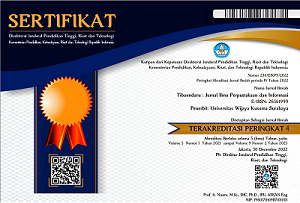Effects of Ease of Use and Usefulness on User Satisfaction in Academic Library Self-Service
Abstract
Purpose Research: Digital transformation in academic libraries drives service innovation to meet the evolving needs of users. This study examines the influence of perceived ease of use and perceived usefulness on user satisfaction with self-service borrowing at the Sebelas Maret University Library. Understanding these factors is critical for enhancing service quality and fostering user loyalty in digital library environments. Research Method: This study employs a quantitative survey design. Data were collected from 30 active users of the self-service borrowing system at Sebelas Maret University Library via structured questionnaires administered online. Respondents’ perceptions of ease of use, usefulness, and satisfaction were measured using a Likert scale. Data Analysis: Descriptive statistics were used to summarize respondents’ perceptions. Simple linear regression analysis was conducted to assess the effects of perceived ease of use and perceived usefulness on user satisfaction. All analyses were performed using SPSS software. Results: Descriptive analysis revealed mean scores of 3.29 for both perceived ease of use and perceived usefulness, and 3.15 for user satisfaction. Regression results demonstrated that perceived ease of use (β = 0.56, p = 0.005) and perceived usefulness (β = 0.51, p = 0.010) significantly influenced user satisfaction, explaining 21–25% of the variance. Conclusions: The findings confirm that perceived ease of use and perceived usefulness are significant determinants of user satisfaction with self-service borrowing systems. Academic libraries should prioritize the development of intuitive, efficient, and beneficial services to enhance user satisfaction and loyalty. Future research should incorporate larger samples and additional variables to deepen the understanding of factors influencing satisfaction in digital library services.
Keywords: Perceived Ease of Use; Perceived Usefulness; User Satisfaction; Academic Library
Full Text:
PDFReferences
Adyolga, D., & Ardoni, A. (2023). Persepsi pemustaka terhadap peminjaman koleksi secara mandiri di Perpustakaan Universitas Andalas. Educational Journal: General and Specific Research, 3(1), 148–153. https://adisampublisher.org/index.php/edu/article/view/278
Ajith, J. A., Ramanayaka, K. H., & Weerasooriya, W. A. (2025). Assessing the effectiveness of academic library services: A review on the formulation of a feasible conceptual framework. Information Development, 41(1), 120–137. https://doi.org/10.1177/02666669231161588
Bae, K. J., & Cha, S. J. (2015). Analysis of the factors affecting the quality of service in public libraries in Korea. Journal of Librarianship and Information Science, 47(3), 173–186. https://doi.org/10.1177/0961000614532483
Bhattacherjee, A. (2001). Understanding information systems continuance: An expectation-confirmation model. MIS Quarterly, 25(3), 351–370. https://doi.org/10.2307/3250921
Davis, F. D. (1989). Perceived usefulness, perceived ease of use, and user acceptance of information technology. MIS Quarterly, 13(3), 319–340. https://doi.org/10.2307/249008
Elias, J. D., & Lubua, E. W. (2024). The impact of usability, functionality and reliability on users’ satisfaction during library system adoption. The Journal of Informatics, 1(1), 13–21. https://doi.org/10.59645/tji.v1i1.13
Gordon, I. D. (2021). Toughest job in the library. Library Management, 42(1/2), 46–55. https://doi.org/10.1108/lm-04-2020-0072
Hair, J. F., Black, W. C., Babin, B. J., & Anderson, R. E. (2010). Multivariate data analysis (7th ed.). New Jersey: Pearson Prentice Hall.
Hertzog, M. A. (2008). Considerations in determining sample size for pilot studies. Research in Nursing & Health, 31(2), 180–191. https://doi.org/10.1002/nur.20247
Husnah, H., Latifa, M., Zulfitri, Z., & Rahmi, L. (2024). Inovasi layanan perpustakaan UIN Imam Bonjol Padang untuk pemenuhan kebutuhan informasi dosen. IQRA: Jurnal Perpustakaan dan Informasi, 18(1), 138–159. https://doi.org/10.30829/iqra.v18i1.17948
Johanson, G. A., & Brooks, G. P. (2010). Initial scale development: Sample size for pilot studies. Educational and Psychological Measurement, 70(3), 394–400. https://doi.org/10.1177/0013164409355692
Machali, I. (2021). Metode penelitian kuantitatif (panduan praktis merencanakan, melaksanakan, dan analisis dalam penelitian kuantitatif). Yogyakarta: Fakultas Ilmu Tarbiyah dan Keguruan
Mascha, E. J., & Vetter, T. R. (2018). Significance, errors, power, and sample size: The blocking and tackling of statistics. Anesthesia & Analgesia, 126(2), 691–698. https://doi.org/10.1213/ANE.0000000000002741
Meuter, M. L., Ostrom, A. L., Roundtree, R. I., & Bitner, M. J. (2000). Self-service technologies: Understanding customer satisfaction with technology-based service encounters. Journal of Marketing, 64(3), 50–64. https://doi.org/10.1509/jmkg.64.3.50.18024
Parasuraman, A., Zeithaml, V. A., & Malhotra, A. (2005). E-S-QUAL: A multiple-item scale for assessing electronic service quality. Journal of Service Research, 7(3), 213–233. https://doi.org/10.1177/1094670504271156
Park, N., Roman, R., Lee, S., & Chung, J. E. (2009). User acceptance of a digital library system in developing countries: An application of the technology acceptance model. International Journal of Information Management, 29(3), 196–209. https://doi.org/10.1016/j.ijinfomgt.2008.07.001
Perpustakaan Nasional Republik Indonesia. (2022). Peraturan Perpustakaan Nasional Republik Indonesia Nomor 2 Tahun 2022 tentang Pedoman Akreditasi Perpustakaan [Peraturan Perpustakaan]. Berita Negara Republik Indonesia No. 164.
Pratiwi, K. Y., & Suprihatin, S. (2019). Analisis usability sistem informasi layanan mandiri di Perpustakaan Universitas Brawijaya. Jurnal Pustaka Ilmiah, 5(2), 931–942. https://doi.org/10.20961/jpi.v5i2.37880
Thabane, L., Ma, J., Chu, R., Cheng, J., Ismaila, A., Rios, L. P., Robson, R., Thabane, M., Giangregorio, L., & Goldsmith, C. H. (2010). A tutorial on pilot studies: The what, why and how. BMC Medical Research Methodology, 10, 1. https://doi.org/10.1186/1471-2288-10-1
Usadha, I. D. N., & Sucandrawati, A. S. (2024). Implementasi metode Webqual pada kualitas pelayanan website Grab. Jurnal Satyagraha, 7(1). http://dx.doi.org/10.47532/jis.v7i1.995
Venkatesh, V., Morris, M. G., Davis, G. B., & Davis, F. D. (2003). User acceptance of information technology: Toward a unified view. MIS Quarterly, 27(3), 425–478. https://doi.org/10.2307/30036540
Wheeler, T. R., Delgado, D., Albert, P. J., Ben Maamar, S., & Oxley, P. R. (2022). Transforming and extending library services by embracing technology and collaborations: A case study. Health Information & Libraries Journal, 39(3), 294–298. https://doi.org/10.1111/hir.12439
Whitehead, A. L., Julious, S. A., Cooper, C. L., & Campbell, M. J. (2016). Estimating the sample size for a pilot randomised trial to minimise the overall trial sample size for the external pilot and main trial for a continuous outcome variable. Statistical Methods in Medical Research, 25(3), 1057–1073. https://doi.org/10.1177/0962280215588241
Xavier, E. K., Putra, J., & Anita, T. L. (2023). Customer satisfaction from the self–service kiosks’ UI/UX and the customer continuance intention to use. In E3S Web of Conferences (Vol. 426, p. 01083). EDP Sciences. https://doi.org/10.1051/e3sconf/202342601083
Zeithaml, V. A., Parasuraman, A., & Malhotra, A. (2002). Service quality delivery through web sites: A critical review of extant knowledge. Journal of the Academy of Marketing Science, 30(4), 362–375. https://doi.org/10.1177/009207002236911
DOI: http://dx.doi.org/10.30742/tb.v9i2.4494
Refbacks
- There are currently no refbacks.

This work is licensed under a Creative Commons Attribution-NonCommercial 4.0 International License.
Tibanndaru: Jurnal Ilmu Perpustakaan dan Informasi is indexing by:
Reference Management Tools

![]()


.png)






